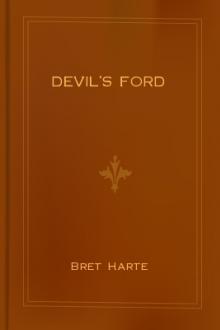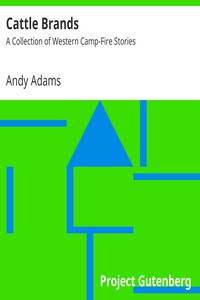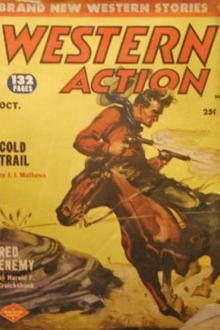The Log of a Cowboy: A Narrative of the Old Trail Days, Andy Adams [knowledgeable books to read .txt] 📗

- Author: Andy Adams
Book online «The Log of a Cowboy: A Narrative of the Old Trail Days, Andy Adams [knowledgeable books to read .txt] 📗». Author Andy Adams
The next morning Flood started to the east and Priest to the west to look out a crossing, for we were then within half a day's drive of the creek. Big Boggy paralleled the Solomon River in our front, the two not being more than five miles apart. The confluence was far below in some settlements, and we must keep to the westward of all immigration, on account of the growing crops in the fertile valley of the Solomon. On the westward, had a favorable crossing been found, we would almost have had to turn our herd backward, for we were already within the half circle which this creek described in our front. So after the two men left us, we allowed the herd to graze forward, keeping several miles to the westward of the trail in order to get the benefit of the best grazing. Our herd, when left to itself, would graze from a mile to a mile and a half an hour, and by the middle of the forenoon the timber on Big Boggy and the Solomon beyond was sighted. On reaching this last divide, some one sighted a herd about five or six miles to the eastward and nearly parallel with us. As they were three or four miles beyond the trail, we could easily see that they were grazing along like ourselves, and Forrest was appealed to to know if it was the Millet herd. He said not, and pointed out to the northeast about the location of the Millet cattle, probably five miles in advance of the stranger on our right. When we overtook our wagon at noon, McCann, who had never left the trail, reported having seen the herd. They looked to him like heavy beef cattle, and had two yoke of oxen to their chuck wagon, which served further to proclaim them as strangers.
Neither Priest nor Flood returned during the noon hour, and when the herd refused to lie down and rest longer, we grazed them forward till the fringe of timber which grew along the stream loomed up not a mile distant in our front. From the course we were traveling, we would strike the creek several miles above the regular crossing, and as Forrest reported that Millet was holding below the old crossing on a small rivulet, all we could do was to hold our wagon in the rear, and await the return of our men out on scout for a ford. Priest was the first to return, with word that he had ridden the creek out for twenty-five miles and had found no crossing that would be safe for a mud turtle. On hearing this, we left two men with the herd, and the rest of the outfit took the wagon, went on to Boggy, and made camp. It was a deceptive-looking stream, not over fifty or sixty feet wide. In places the current barely moved, shallowing and deepening, from a few inches in places to several feet in others, with an occasional pool that would swim a horse. We probed it with poles until we were satisfied that we were up against a proposition different from anything we had yet encountered. While we were discussing the situation, a stranger rode up on a fine roan horse, and inquired for our foreman. Forrest informed him that our boss was away looking for a crossing, but we were expecting his return at any time; and invited the stranger to dismount. He did so, and threw himself down in the shade of our wagon. He was a small, boyish-looking fellow, of sandy complexion, not much, if any, over twenty years old, and smiled continuously.
"My name is Pete Slaughter," said he, by way of introduction, "and I've got a herd of twenty-eight hundred beef steers, beyond the trail and a few miles back. I've been riding since daybreak down the creek, and I'm prepared to state that the chance of crossing is as good right here as anywhere. I wanted to see your foreman, and if he'll help, we'll bridge her. I've been down to see this other outfit, but they ridicule the idea, though I think they'll come around all right. I borrowed their axe, and to-morrow morning you'll see me with my outfit cutting timber to bridge Big Boggy. That's right, boys; it's the only thing to do. The trouble is I've only got eight men all told. I don't aim to travel over eight or ten miles a day, so I don't need a big outfit. You say your foreman's name is Flood? Well, if he don't return before I go, some of you tell him that he's wasting good time looking for a ford, for there ain't none."
In the conversation which followed, we learned that Slaughter was driving for his brother Lum, a widely known cowman and drover, whom we had seen in Dodge. He had started with the grass from north Texas, and by the time he reached the Platte, many of his herd would be fit to ship to market, and what were not would be in good demand as feeders in the corn belt of eastern Nebraska. He asked if we had seen his herd during the morning, and on hearing we had, got up and asked McCann to let him see our axe. This he gave a critical examination, before he mounted his horse to go, and on leaving said,—
"If your foreman don't want to help build a bridge, I want to borrow that axe of yours. But you fellows talk to him. If any of you boys has ever been over on the Chisholm trail, you will remember the bridge on Rush Creek, south of the Washita River. I built that bridge in a day with an outfit of ten men. Why, shucks! if these outfits would pull together, we could cross to-morrow evening. Lots of these old foremen don't like to listen to a cub like me, but, holy snakes! I've been over the trail oftener than any of them. Why, when I wasn't big enough to make a hand with the herd,—only ten years old,—in the days when we drove to Abilene, they used to send me in the lead with an old cylinder gun to shoot at the buffalo and scare them off the trail. And I've made the trip every year since. So you tell Flood when he comes in, that Pete Slaughter was here, and that he's going to build a bridge, and would like to have him and his outfit help."
Had it not been for his youth and perpetual smile, we might have taken young Slaughter more seriously, for both Quince Forrest and The Rebel remembered the bridge on Rush Creek over on the Chisholm. Still there was an air of confident assurance in the young fellow; and the fact that he was the trusted foreman of Lum Slaughter, in charge of a valuable herd of cattle, carried weight with those who knew that drover. The most unwelcome thought in the project was that it required the swinging of an axe to fell trees and to cut them into the necessary lengths, and, as I have said before, the Texan never took kindly to manual labor. But Priest looked favorably on the suggestion, and so enlisted my support, and even pointed out a spot where timber was most abundant as a suitable place to build the bridge.
"Hell's fire," said Joe Stallings, with infinite contempt, "there's thousands of places to build a bridge, and the timber's there, but the idea is to cut it." And his sentiments found a hearty approval in the majority of the outfit.
Flood returned late that evening, having ridden as far down the creek as the first settlement. The Rebel, somewhat antagonized by the attitude of the majority, reported the visit and message left for him by young Slaughter. Our foreman knew him by general reputation amongst trail bosses, and when Priest vouched for him as the builder of the Rush Creek bridge on the Chisholm trail, Flood said, "Why, I crossed my herd four years ago on that Rush Creek bridge within a week after it was built, and wondered who it could be that had the nerve to undertake that task. Rush isn't over half as wide a bayou as Boggy, but she's a true little sister to this miry slough. So he's going to build a bridge anyhow, is he?"
The next morning young Slaughter was at our camp before sunrise, and never once mentioning his business or waiting for the formality of an invitation, proceeded to pour out a tin cup of coffee and otherwise provide himself with a substantial breakfast. There was something amusing in the audacity of the fellow which all of us liked, though he was fifteen years the junior of our foreman. McCann pointed out Flood to him, and taking his well-loaded plate, he went over and sat down by our foreman, and while he ate talked rapidly, to enlist our outfit in the building of the bridge. During breakfast, the outfit listened to the two bosses as they discussed the feasibility of the project,—Slaughter enthusiastic, Flood reserved, and asking all sorts of questions as to the mode of procedure. Young Pete met every question with promptness, and assured our foreman that the building of bridges was his long suit. After breakfast, the two foremen rode off down the creek together, and within half an hour Slaughter's wagon and remuda pulled up within sight of the regular crossing, and shortly afterwards our foreman returned, and ordered our wagon to pull down to a clump of cotton woods which grew about half a mile below our camp. Two men were detailed to look after our herd during the day, and the remainder of us returned with our foreman to the site selected for the bridge. On our arrival three axes were swinging against as many cottonwoods, and there was no doubt in any one's mind that we were going to be under a new foreman for that day at least. Slaughter had a big negro cook who swung an axe in a manner which bespoke him a job for the day, and McCann was instructed to provide dinner for the extra outfit.
The site chosen for the bridge was a miry bottom over which oozed three or four inches of water, where the width of the stream was about sixty feet, with solid banks on either side. To get a good foundation was the most important matter, but the brush from the trees would supply the material for that; and within an hour, brush began to arrive, dragged from the pommels of saddles, and was piled into the stream. About this time a call went out for a volunteer who could drive oxen, for the darky was too good an axeman to be recalled. As I had driven oxen as a boy, I was going to offer my services, when Joe Stallings eagerly volunteered in order to avoid using an axe. Slaughter had some extra chain, and our four mules were pressed into service as an extra team in snaking logs. As McCann was to provide for the inner man, the mule team fell to me; and putting my saddle on the nigh wheeler, I rode jauntily past Mr. Stallings as he trudged alongside his two yoke of oxen.
About ten o'clock in the morning, George Jacklin, the foreman of the Millet herd, rode up with several of his men, and seeing the bridge taking shape, turned in and assisted in dragging brush for the foundation. By the time all hands knocked off for dinner, we had a foundation of brush twenty feet wide and





Comments (0)